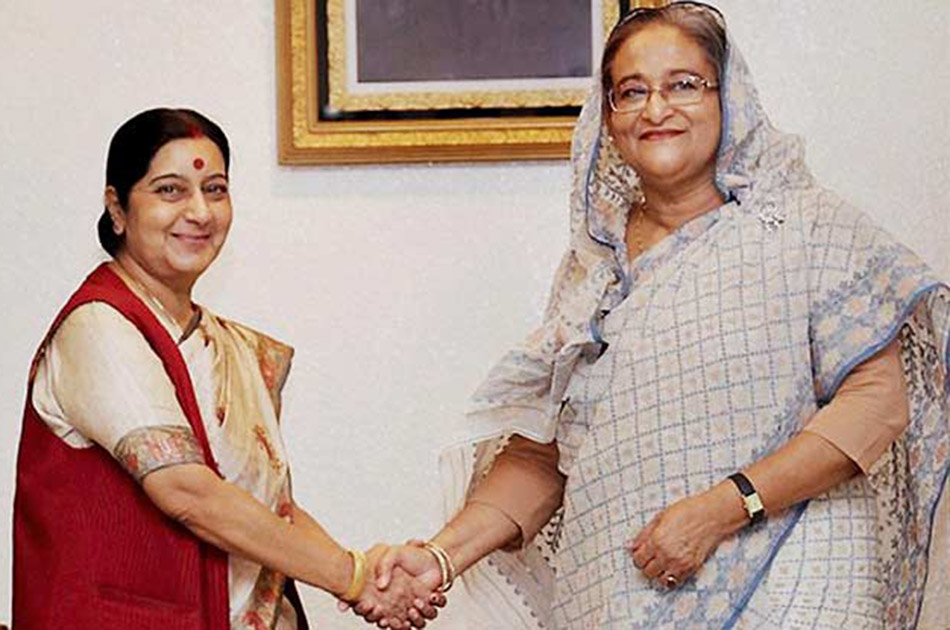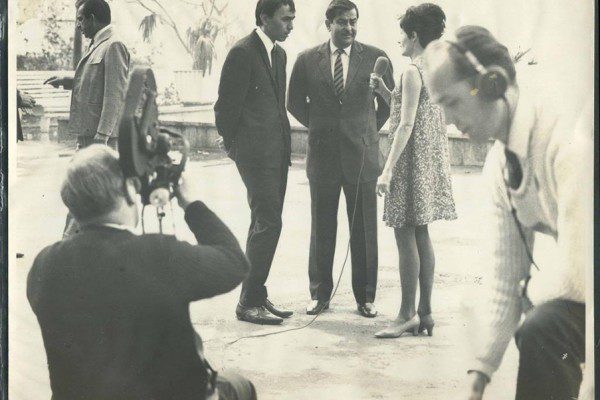Soumabrata Chatterjee describes the Indo-Bangladesh relations, how it has developed over time and space and what the future looks like with the advent of the BJP-led government in India ..
In 2014, Foreign Minister Sushma Swaraj made it a point to make Bangladesh her first overseas visit. This political gesture on part of BJP follows a long history of convoluted political camaraderie between the two countries. The historical evolution of Indo-Bangladesh relations over time and space hasn’t been a smooth journey and has had its own share of pitfalls.
India and Bangladesh are so geographically, culturally and politically linked that they are bound to have complicated bilateral relations. Nationality is linked to the act of memory; it is about remembering where you come from, your lineage, your heritage… The violence of 1947 that haunts their collective memory turns India and Bangladesh into unrelenting political antagonists. India’s participation in the 1971 war and it’s recognition of Bangladesh as a separate state led to the signing of a “Treaty of Friendship and Peace” in 1972 in order to ensure the operational independence of both these countries without interference from the other.
The assassination of Mujibur-ur-Rehman in 1975 and the coming to power of General Zia-ur-Rahman after a coup disturbed Indo-Bangladesh relations. This phase can also be marked as a shift in the politics of nationalism in Bangladesh. The rhetoric of nationalism which played a huge role in the fight for sovereignty against Pakistan was done away with in the wake of the new Islamic ideology. From the ideals of nationalism, democracy, socialism and secularism Bangladesh slowly moved towards an Islam-oriented state. In fact this ideology was used to legitimate governments in Bangladesh and also worked as a cause of dissent against India who was a powerful presence in South-east Asian political economy.
Over time, both countries realised the need to cooperate which resulted in the 1977 agreement regarding the water of Ganges being used in the dry season by both countries. In 1992, India agreed to give Bangladesh a lease over Tin Bigha corridor 1.5 hectares which were separating Bangladeshi nationals from their homeland. However, presently the Indian government looks at it suspiciously as an enclave of immigrants.
The coming to power of the Bharatiya Janata Party in 1998 was not auspiciously viewed because of its Hindu nationalist ideals. However, the return of the more ‘secular’ Congress party in 2004 led to the relations being improved. But India didn’t visit the SAARC summit in Dhaka in 2005 owing to law and order problems.
A variety of problems regarding geographical domination disturbs the relation between India and Bangladesh. India shares a 4,094 km long border with its neighbour thereby its regional hegemony. The fight against Pakistan was a strategic step too as it undercut its presence on both sides.
On the other hand, if we investigate the relation between Bangladesh and Pakistan we would realise that the picture is a bit coloured at the edges. Their relation was quite embittered due to the war atrocities but they seem to find a common altercation in India. In 1974 Pakistan and Bangladesh signed a treaty to recognise each other and even formed diplomatic relations over time.
Also, Bangladesh seems to play the role of an ally to China in order to counterbalance India’s preponderance in South-Asian politics. Beijing also welcomes such an alliance because it helps them to stamp their authority and of course underline their political animosity with India. The two countries, Bangladesh and China have also signed a Defense Cooperation Agreement in 2002 that covers military production and also help the former with resources needed to bolster its own statist apparatuses. They have also signed a nuclear treaty which engages in the fields of medicine, agriculture and biotechnology. The natural gas reserves in Bangladesh are important for China and the latter’s inclusion in SAARC is supported by the former.
We have to consider the case of the Ledo Road (renamed to Stilwell road after General Joseph Stilwell of the U.S. army) which stretches from the Indian states of Assam through Bangladesh to the Yunnan province in southern China. It was built during World War II to facilitate the Western allies to provide supplies to the Chinese instead of the Burmese road which was cut off by the Japanese. In 1999, China, India, Myanmar and Bangladesh came together in something known as the “Kunming initiative” to propose the revival of this road because it will boost India’s trade relations with the rest of South Asia. The Chinese Government completed the construction of the Myitkyina-Kambaiti section in 2007. But India has been reconsidering because it fears it will boost the influx of Chinese goods in Indian markets. It will also provide easy passage to militants in North-east India whco have hideouts in Myanmar.
Domestic and foreign policy in Bangladesh features India as a major factor. The Awami league is considered close to India and thus every other party tends to create their identity in opposition to India. When the Bangladesh Nationalist Party led coalition came to power in 2001, Indian Government sent a special emissary to Dhaka to ensure that was no bad water between the two polities. But that didn’t seem to work quite well.
In fact politics in Bangladesh have been quite personalised over the years. The Awami League is led by the current Prime Minister Sheikh Hasina who is the eldest daughter of Sheikh Mujibur Rahman, the first President of Bangladesh. Her political rival is Khaleda Zia, Chairperson of the Bangladesh Nationalist Party. Bangladesh politics is a bitter power play between the two of them which has often put the country on the verge of chaos.
The army in Bangladesh has made its way into politics as well. In the aftermath of the massacre of the ruling members of Awami league including Sheikh Mujibur Rahman, General Zia-ur-Rahman transformed the state from a secular, socialist state to an Islamic, socialist republic. He interacted with the Islamic fundamentalists of the Middle East and welcomed their influence. His successor General Hussain Mohammed Ershad continued the same trend. So the army has a distinct anti-India tendency.
The growth of radical Islam in Bangladesh owes a lot to the political rivalry between the Awami League and the BNP which has portrayed the political ineptitude of parliamentary democracy in the country. Political parties which have a strong Islamic base have targeted Hindus who are perceived to be the supporters of the left-oriented Awami League. The Economist called the 2001 parliamentary elections a “vote for Bin Laden” because of the presence of his countenance in numerous posters.
When we look at BJP’s attitude in relation to Bangladesh we would find that they are more eager to blame the latter for their lax treatment of the illegal immigrant issue. Also, their embedded Hindutva agenda kind of makes way for an antagonistic relation between the two. On one hand, the Congress Party has accused BJP’s agenda to be sectarian but on the other hand, the BJP has blamed the Congress party for its lackadaisical politics which has, they argue, resulted in the appeasement of minorities and subduing the country’s interests.
It is to be seen whether BJP can move out of its Hindutva-nationalist agenda and forge a long-standing relation with Bangladesh which would be beneficial for both countries.














